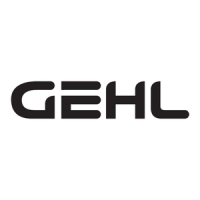SAFETY
ADDITIONAL SAFETY REMINDERS
 User/operator safety practices, as established by
industry standards, are included in this Operator’s
Manual and intended to promote safe operation of
the machine. These guidelines do not, of course,
preclude the use of good judgment, care and com-
mon sense as may be indicated by the particular
jobsite work conditions. It is essential that opera-
tors be physically and mentally free of mind alter-
ing drugs and chemicals.
 Some illustrations used in this manual may show
doors, guards and shields open or removed for
illustration purposes only. BE SURE that all doors,
guards and shields are in their proper operating
positions BEFORE starting the engine to operate
the machine.
 Any or all of the following elements can affect the
stability of the machine: The terrain, the engine
PRINTED IN U.S.A. 11 907879/AP1198
speed, the type of load being carried and placed,
and the abrupt movement of any control lever. IF
YOU ARE NOT CAREFUL WHILE OPERAT-
ING THIS MACHINE, ANY OF THE ABOVE
FACTORS COULD CAUSE THE MACHINE
TO TIP AND THROW YOU OUT OF THE
OPERATOR’S STATION, WHICH MAY
RESULT IN SERIOUS INJURY OR DEATH!
 ALWAYS wear the seat belt to prevent being
thrown from the machine. If you are in an over-
turn:
- DO NOT jump!
- Hold on tight and stay with the machine!
- Lean away from the fall!
 ALWAYS keep hands, feet and arms inside of the
operator’s station when operating the machine!
 ALWAYS wear appropriate personal protective
equipment called for by the job and working con-
ditions. Hard hats, protective glasses, protective
shoes, gloves, reflector type vests, respirators and
ear protection are examples of types of equipment
that may be required. DO NOT wear loose or
baggy clothing, long hair, jewelry or loose person-
al items while operating or servicing the machine.
 ALWAYS be aware of pinch point areas on the
machine such as wheels-to-frame, cylinders-to-
frame, boom and attachment tool-to-frame, etc.
 ALWAYS maintain safe clearance from electrical
power lines and avoid contact with any electrical-
ly charged conductor. Contact can result in electro-
cution. Contact proper local authorities for utility
line location BEFORE starting a job.
 ALWAYS check the job site for terrain hazards,
obstructions and people. Remove all objects which
do not belong in or on the machine and its equip-
ment.
WARNING
U.S. OSHA regulations require employers in
general industry and the construction, ship-
yard and cargo-handling industries (excepting
agricultural operations) to ensure that forklift
operators are competent, as demonstrated by
successful completion of a training course.
The training course must consist of a combi-
nation of formal instruction and practical
training, including both forklift-related and
workplace-related topics, and evaluation of
the operator’s performance in the workplace.
All operator training and evaluation is to be
conducted by persons who have the knowl-
edge, training and experience to train and
evaluate operators.
Courtesy of CraneMarket.com

